Raising Scotland's tobacco-free generation: our tobacco control action plan 2018
Five-year action plan setting out interventions and policies to help reduce the use of and associated harms from using tobacco in Scotland.
Annex
Tobacco Control: Smoking and Vaping Statistics 2018
Background
1. In Scotland, smoking is still the largest preventable cause of ill health and premature death as 10,000 deaths associated with tobacco use are recorded each year [19] (around a fifth of all deaths). Scottish Government policy wishes to create a ‘Smoke Free Generation’ by reducing prevalence to 5% by 2034. The new Tobacco control strategy will put in place five year goals to drastically reduce take up by adolescents and to help as many people quit as possible, whatever their method.
Smoking prevalence amongst adults in Scotland
2. By using data from the Scottish Health Survey (2016), adult smoking prevalence in Scotland is 21% on average. In the most deprived area quintile this prevalence is as high as 32% and 12% in the least deprived quintile [20] .
| Date |
SIMD 1 |
SIMD 2 |
SIMD 3 |
SIMD 4 |
SIMD 5 |
Scotland Average |
|---|---|---|---|---|---|---|
| 2011 |
38 |
39 |
22 |
16 |
12 |
23% |
| 2016 |
27 |
21 |
18 |
13 |
10 |
17% |
| 2021 |
19 |
15 |
13 |
10 |
7 |
12% |
| 2026 |
13 |
10 |
9 |
7 |
5 |
9% |
| 2031 |
9 |
7 |
6 |
5 |
4 |
6% |
| 2036 |
7 |
5 |
5 |
4 |
3 |
4% |
3. To reach our goal of 5% prevalence by 2034, more work needs to be done because current prevalence trend suggest this value should be 17% on average, 27% in the most deprived quintile and 9% in the least deprived quintile. [21]
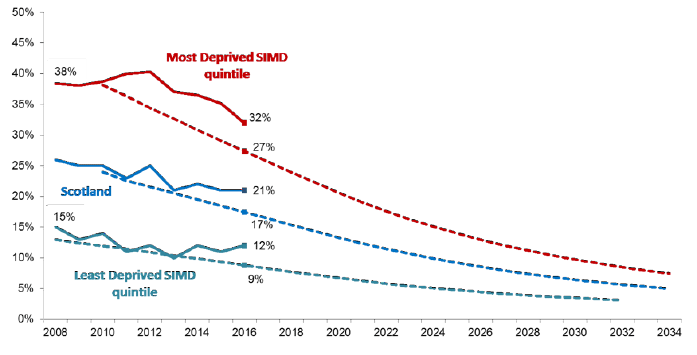
Comparisons within the UK
4. Smoking prevalence is still slightly higher in Scotland than in England and Wales. Source is from the Annual Population Survey, 2016.
- England 16%
- Scotland 18%
- Wales 17%
- Northern Ireland 18%
Most smokers want to quit
5. Results from the Scottish Health Survey observed that 81% of smokers have attempted to quit at least once, with 44% attempting to quit three times or more [22] .
6. From this 81% of smokers trying to quit, 36% described using nicotine patches, 34% using e-cigarettes and 37% using some forms of support from cessation services [23] .
Declining use of NHS Stop-Smoking Services
7. There were around 60,000 quit attempts in 2016/17 using NHS services, which continues a decline for the past 5 years. There has been a 51% decrease in use of services since 2011/2012 [24] . The majority of cessation seekers are using pharmacy services – around 70%. It is also possible that an increase of successful quit attempts would decrease NHS service use.
8. In England, cessation services are still very popular, with 81% of quit attempts occurring using specialist services. Source: Information Statistics Division, NHS National Services Scotland, 2016/17
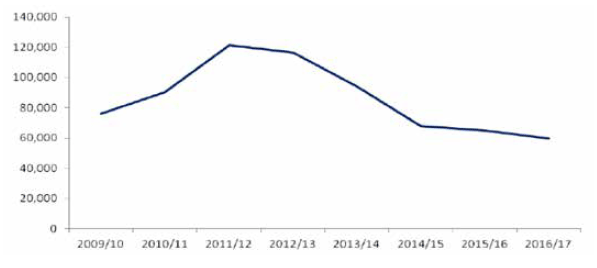
Successful quitters
9. Around 23% of people going through a quit attempt are successful for at least 12 weeks (longer timescale data is not available). The proportion of successful quits at 12 week is higher (at 33%) for those using GP or other specialist services than for those using pharmacy services (18%) [25] .
There is a large variation in successful quits across NHS Boards. This is largely due to variation in the balance of GP and other specialist services versus pharmacy services in different boards and differing levels of deprivation.
10. There is a clear pattern between success of quit attempts and deprivation with the lowest quit rates seen in the most deprived areas. Although the number of attempted quits has been reducing, the proportion of quit attempts which were successful has been increasing since 2013/14 across all deprivation quintiles [26] .
Figure 11: Percentage of successful 12 week quit attempts by deprivation quintiles: Scotland; 2009/10 - 2016/17
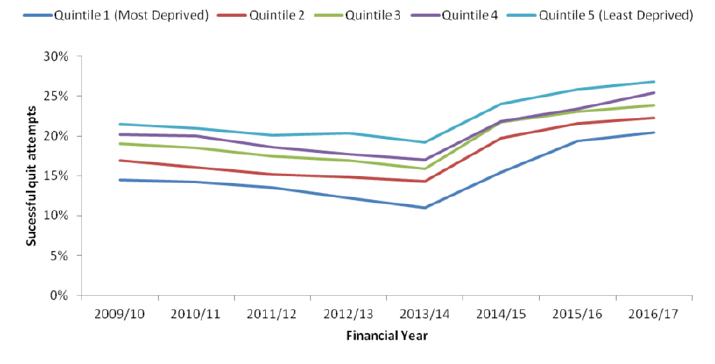
Varenicline as a cessation tool
11. Varenicline is a form of NRT that reduces cravings and decreases the pleasure effects of tobacco. The 12 week quit rate for those prescribed varenicline is 37% (compared to 21% for service users using NRT products). For those using varenicline and non-pharmacy services, the 12 week quit rate is even higher at 47%. Only 11% of smoking cessation service users are currently prescribed varenicline. The drug is more widely prescribed in England.
More quits in prisons
12. Currently 72% of prisoners smoke cigarettes [27] yet all Prisons are to go smoke-free in Scotland by the end of 2018.
Since 2013/14 the number of reported quit attempts made across the fifteen prisons in Scotland has increased year-on-year from 650 in 2013/14 to 1,625 in 2016/17. This is due to both increased participation from prisons in smoking cessation services and better data collection and reporting.
Figure13: Number of quit attempts, 4 and 12 week quits in Scotland's Prisons; 2013/14 - 2016/17
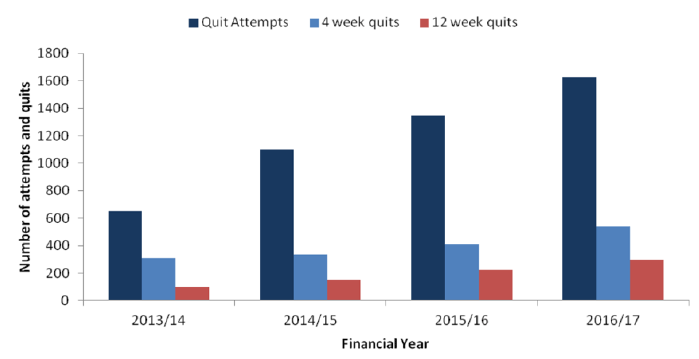
E-cigarette use
13. The use of e-cigarettes has settled at around 7%, in both 2015 and 2016. The vast majority of e-cigarette users are former smokers (37%) or current smokers/dual users (60%), very few start the habit without smoking cigarettes first (3%). Only 4% of 16-24 year old use e-cigarettes, and 1-4% of over 65 year olds use them as well. The highest percentage users are those between the ages of 25-64 (8-10%) [28] .
Second Hand Smoke in adults
14. Exposure to second hand smoke has decreased substantially since 2003. 78% of non-smoking adults have no cotinine detected in their system compared to only 15% in 2003. Cotinine is breakdown product of nicotine that can be detected easily to objectively show exposure to second hand smoke.
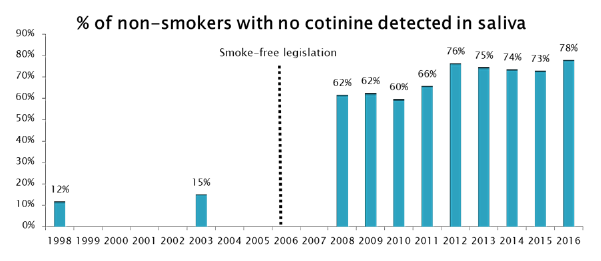
Second Hand smoke in Children
15. The proportion of children’s exposed to second hand smoke in the home decreased from 11% in 2011 to 6% in 2015 and remained at around this level (7%) in 2016 [30] . There is also a large deprivation gap with only 1% of children exposed to second hand smoke in the home in the least deprived areas, compared to 15% in the most deprived areas [31] . There are also variances in the age of the child exposed to second hand smoke in the home: 0-3 year olds (4% exposure), 4-7 year olds (6%), 8-11 (7%), 12-15 (10%). The older the children are, the more they are at risk of being exposed to second hand smoke [32] .
Children smoking rates
16. Fewer children are smoking, and the decline has steadily reduced to 7% regular smoking in 15 year olds and 2% in 13 year olds. The first points of data recorded were from 1982, where 26-29% of 15 year olds and 8-10% of 13 year olds smoke regularly. However, out of those who do smoke, less than a third of 15 year olds want to give up (29%) [33] .
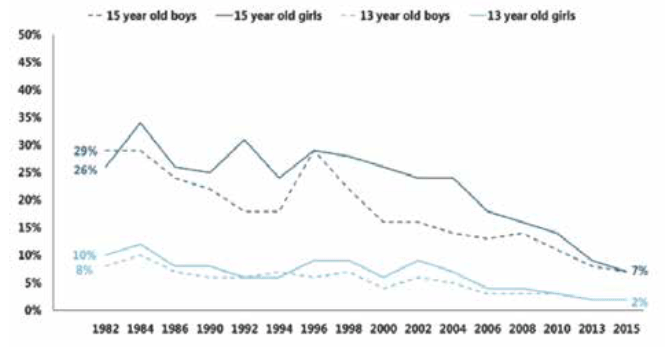
Patterns of smoking use
17. As well as smoking prevalence declining steadily over time, the amount of cigarettes smoked has also declined. In 2003, on average smokers smoked 15.3 cigarettes/day whereas it has declined to 12.7 in 2016 [34] .
Publications
Rapid Evidence Review: What is the causal link between the tobacco outlet density and smoking prevalence? NHS Health Scotland, 2018
Rapid Evidence Review: Strengths and limitations of tobacco taxation and pricing strategies NHS Health Scotland, 2018
The economics of tobacco control: An overview of the 2016 US National Cancer Institute Tobacco Control Monograph, NHS Health Scotland, 2018
Consensus Statement on e-cigarettes, NHS Health Scotland, 2018
Review of “Creating a tobacco-free generation: A Tobacco Control Strategy for Scotland”,
NHS Health Scotland 2017
Tobacco control policy in Scotland: A qualitative study of expert views on successes, challenges and future actions, NHS Health Scotland 2017
Contact
There is a problem
Thanks for your feedback